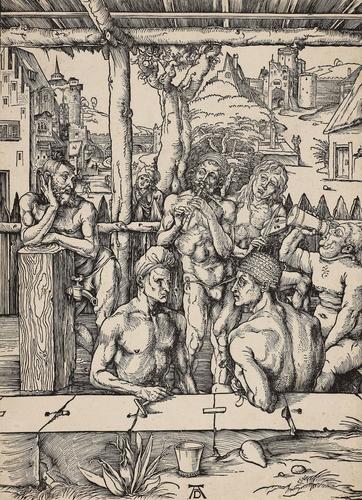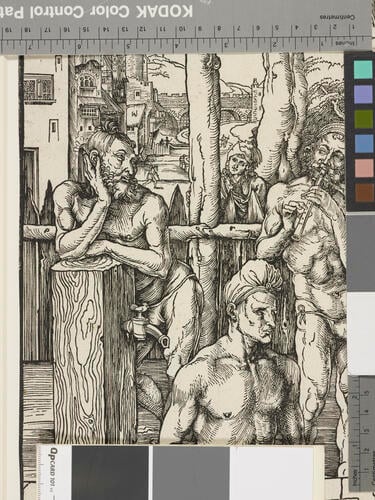-
1 of 253523 objects
Albrecht Dürer (1471-1528)
The Bath House c.1496
Woodcut | 39.3 x 28.5 cm (sheet of paper) | RCIN 800195






-
A woodcut of four men at a male bathhouse (a communal meeting place for both washing and socialising) listening to two musicians. One leans against a water pipe, another drinks from a tankard and two sit in the foreground, one holding a back scraper, the other a carnation. A fifth man observes the group from outside.
This large woodcut dates from around 1496. Just as he would use his 'St Eustace' engraving to present a dog in different attitudes, so here Dürer takes the opportunity to demonstrate his skill at portraying the male nude in varying poses. The print is not simply a study of the male figure however. The man standing against the water pipe is recognisably the artist himself, while the plump seated man drinking is clearly a portrait of Dürer’s friend Willibald Pirckheimer. The two figures in the foreground have been tentatively identified as Lukas and Stephan Paumgartner, friends of Dürer who commissioned, and were portrayed in, an altarpiece by the artist. If the observer in the background is included, the figures stand for the five senses: Dürer as hearing, Pirckheimer as taste, the figure holding the flower as smell, his companion as touch and the onlooker in the background as sight.
The print includes touches of visual humour, such as the suggestive cock-topped tap jutting from the pipe against which Dürer leans. A topical reference may be provided by the fact that the communal baths in Nuremberg were closed in 1496 in an attempt to prevent the spread of syphilis (which was believed to be spread by proximity to sufferers); to a Nuremberg audience the subject matter would have been immediately relevant. But the print clearly had wide appeal, and was reproduced in painted and printed copies almost immediately after its publication.
Albrecht Dürer was the most influential artist of the German Renaissance, whose ground-breaking engravings and woodcuts circulated across Europe and beyond. Especially as a young man, he was fascinated by his own appearance, but more from an urge to self-knowledge than out of vanity: his Christ-like Self-Portrait of 1500 (Alte Pinakothek, Munich) is one of the most striking such images in the whole history of art, but what might appear almost blasphemous was prompted less by self-aggrandisement than by the pious tradition of imitatio Christi, the meditative and devotional ‘imitation’ of Christ, and a humble belief in the God-given nature of artistic inspiration.
Willibald Pirckheimer (1470–1530) came from one of the oldest and richest families in Nuremberg and had studied law and the humanities at the universities of Padua and Pavia; Dürer was the son of a Hungarian immigrant goldsmith. Their friendship from their mid-twenties onwards emphasises that a commonality of intellectual interests could in the Renaissance transcend social barriers. Dürer depicted Pirckheimer on several other occasions – in a charcoal drawing of 1503 (preceded by a metalpoint study inscribed obscenely in Greek) and a portrait engraving of 1524, and as a bystander in works such as Christ Shown to the People from the Large Passion and (alongside Dürer) the painting of the Martyrdom of the Ten Thousand. But while we can appreciate the humour of Dürer’s depiction of himself and his friend here, it was not necessary to recognise them to enjoy the print, which sold in large numbers to people who had no idea what he or Pirckheimer looked like.
Text adapted from Portrait of the Artist, London, 2016Provenance
In the Royal Collection by c.1810
-
Creator(s)
(designer) -
Medium and techniques
Woodcut
Measurements
39.3 x 28.5 cm (sheet of paper)
Category
Object type(s)